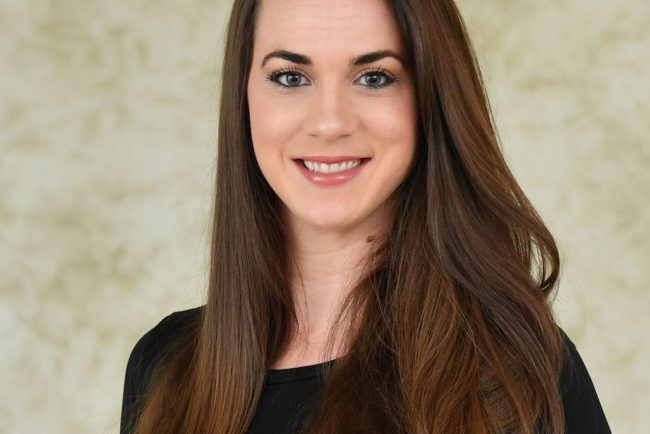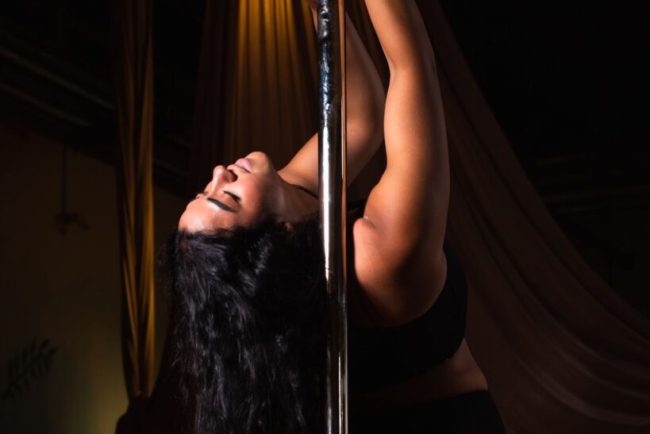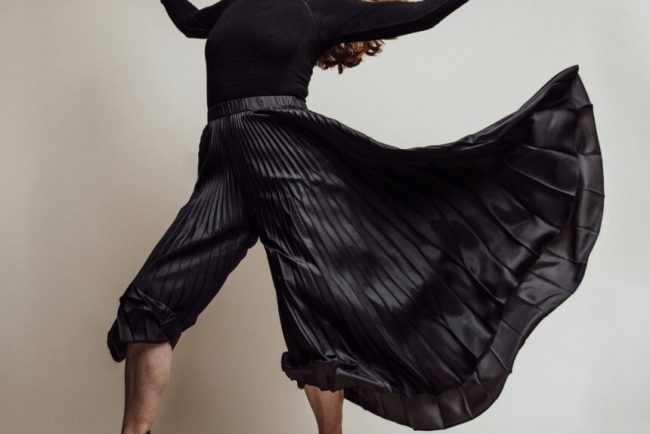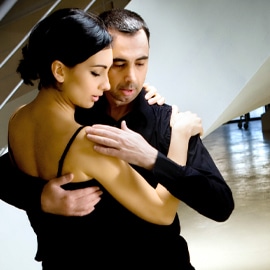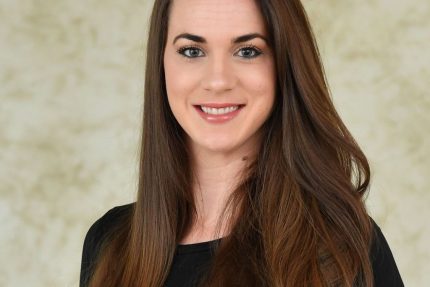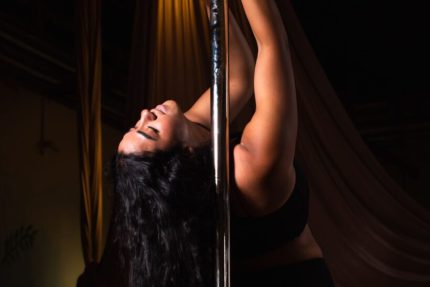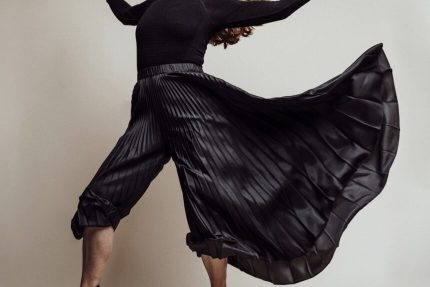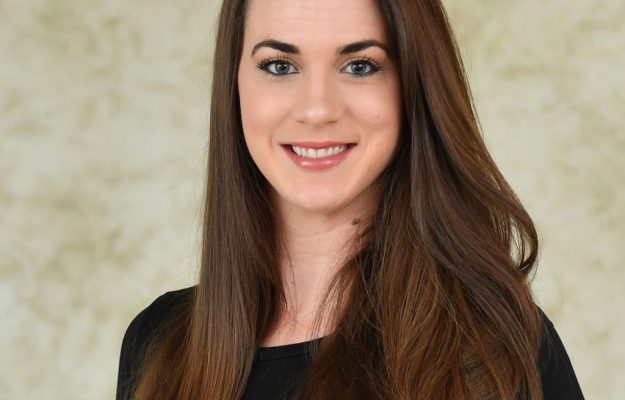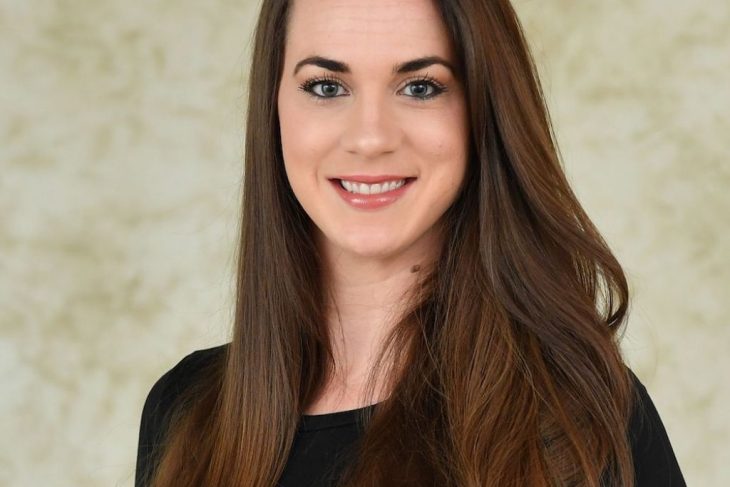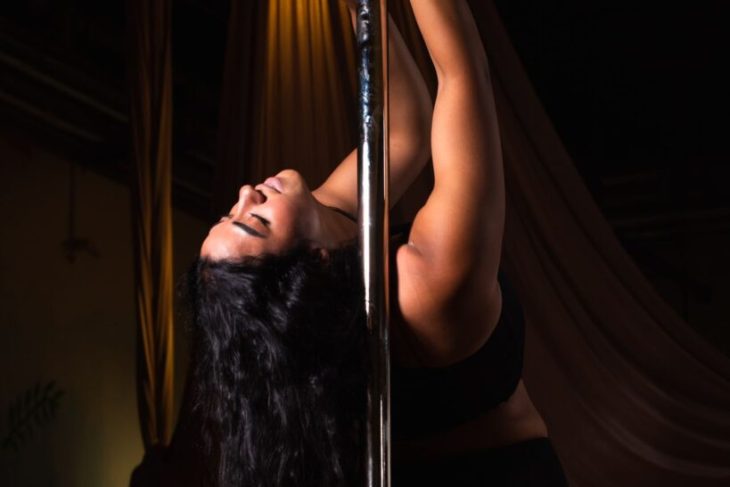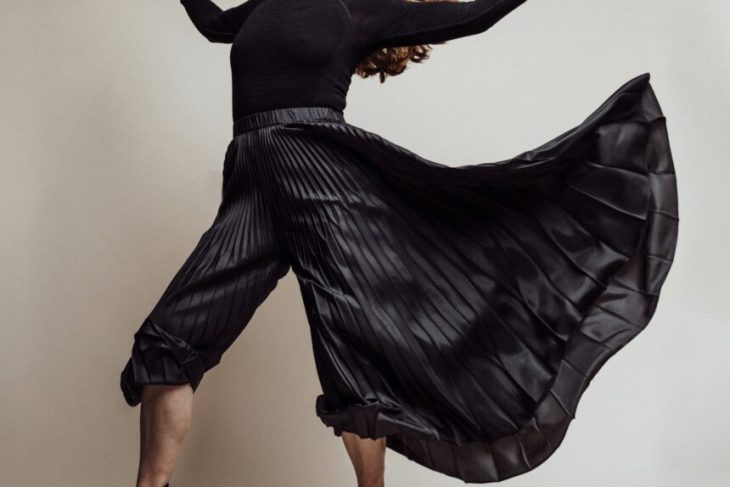by Admin
Jodi Melnick on Her Lifelong Love of Dance
I am deeply, madly, in love with movement. It is one of the great loves of my life, it is my heart. The very unromantic reason why I dance is because it is my vocation, my entire adult life’s work, it is what I do. […]
ran-&-rave
by Admin
Meet Cira Robinson, Senior Artist with Ballet Black
“My growth as a dancer is never over, and that’s one of the many reasons why I still love it,” says Cira Robinson. The Cincinnati native trained under Arthur Mitchell at Dance Theatre of Harlem and joined London’s Ballet Black in 2008. A senior artist […]
ran-&-rave
by Admin
My Experience With Long COVID Forced Me to Acknowledge the Vulnerability of All Bodies
As a dancer, I have always understood how much I depend on my body. But I hadn’t ever thought about how much my world would change if it functioned differently. I thought I was rather invincible, with my young age, agility and health. Then, one […]
ran-&-rave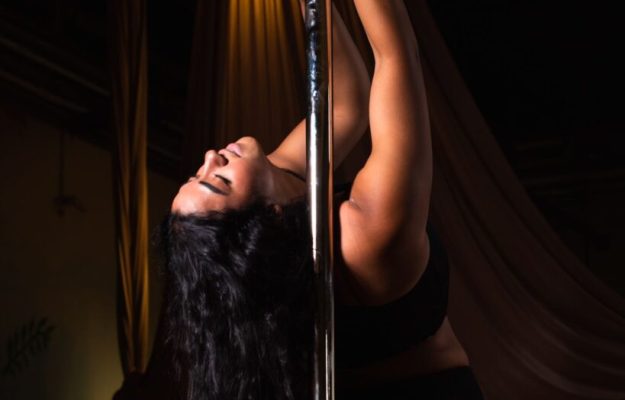
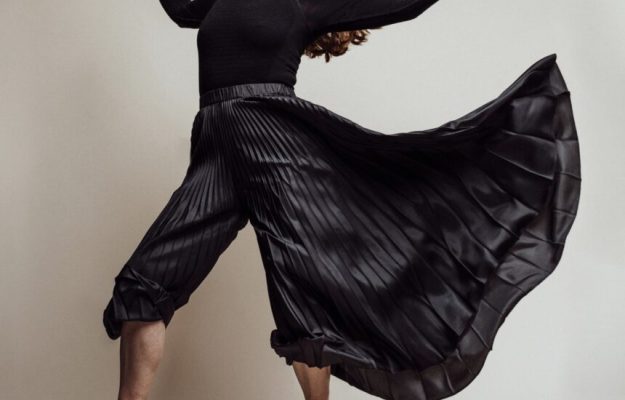
How Can We Confront Implicit Bias? The Director of Jacob's Pillow Shares Her Ideas
by Admin
At Jacob’s Pillow’s June gala, something happened that outraged me: A patron who identifies as black/biracial felt a white man seated behind her touch her tightly coiled hair. When she ignored him, he audibly complained that her hair would block his view of the stage. […]
Dance as activismAt Jacob’s Pillow’s June gala, something happened that outraged me: A patron who identifies as black/biracial felt a white man seated behind her touch her tightly coiled hair. When she ignored him, he audibly complained that her hair would block his view of the stage. At dinner, the patron was further subjected to a series of objectifying questions. “What are you?” asked the white woman sitting next to her. Not “who are you,” but a dehumanizing “what.” “Who was black? Was it your mother or your father? What do your children look like?”
After hearing about this, I couldn’t stay silent. I wrote an op-ed for our regional paper, The Berkshire Eagle, describing how Jacob’s Pillow, like many cultural institutions, is working to create a climate of inclusiveness. “We can diversify the artists…we celebrate onstage, the dancers we teach in our school, and the representation of people of color on our board and staff,” I wrote. “What can we do to evolve our audiences so that our institution is truly inclusive?” I invited readers to share their thoughts.
The article resulted in numerous letters to the editor, and the Pillow received hundreds of responses. The great majority were supportive. One suggested that patrons should be provided with movement experiences that engage these issues. Another noted that after reading the piece, he apologized to a black person whose hair he had touched without permission.
There were a few dissenters. One writer doubted the veracity of the patron’s story. Another suggested that I had made it up for attention.
Patrons lined up to speak to me before performances, some with tears in their eyes. They couldn’t believe this had happened at Jacob’s Pillow. In truth, these kinds of experiences occur regularly to patrons and staff members of color, including our interns.
In 2017, Jacob’s Pillow created a staff cultural-competency committee and began a partnership with Massachusetts-based Multicultural BRIDGE to pursue a set of equity, diversity, inclusion and accessibility initiatives. These have included everything from annual staff and board training to gender-neutral bathroom signage and crafting a code of conduct that’s printed in each program. Despite these positive steps forward, this summer’s incident revealed how much work has yet to be done.
When the patron who was harassed at the gala offered to partner with us, we created a board/staff task force that included her. We’ve made strides in the short term, like posting our statement of values across campus and online, and empowering staff members with language to use if they observe or experience a microaggression. For our guests, a contact person to whom concerns may be reported is now listed with the code of conduct in our programs.
Long-term strategies include bystander training, a campus audit with community partners, and revamping our orientation program so that new staff are better informed about the structures in place to support them. We are also thinking about how to welcome companies from other cultures that may have a different relationship to gender and religion.
So why did this op-ed touch such a collective nerve? In part, I think it’s because of the divisive rhetoric coming from some of our national leadership. But also because cultural institutions have been too slow to recognize the racism and bias embedded in our structures—and have overlooked their implications for too long. I see many institutions working to advance equity, diversity, inclusion and accessibility within their organizations, partially out of a desire to draw a broader range of audience members. But we’re missing a big piece of the equation right now if we don’t think more intentionally about the climate we are creating for the audiences we wish to attract.
I believe we need more education—and accountability—in conversing civilly and respectfully across differences. We need to discuss the many facets of implicit bias, from small to large, so that we all can learn what is and is not appropriate, and create more genuinely welcoming environments for all people.
I’m deeply grateful to the patron who was brave enough to tell me her story. She told me she could not have written an op-ed herself because raising the issue might endanger her school-aged kids. If she’d written it, she said, her piece would never have gotten the attention that my piece, written by a white woman of privilege, did.
As arts leaders, we must do all we can to be advocates and allies. If we want to be both leaders and citizens of our communities, we have to consider who feels that they belong at our institutions, and act in ways that will truly broaden the pathways to inclusion.
The post How Can We Confront Implicit Bias? The Director of Jacob's Pillow Shares Her Ideas appeared first on Dance Magazine.

by Admin
This Dancer Spent a Month in Zion National Park as an Artist in Residence
For ballet dancers, taking daily class is one of the most natural things they can do. But taking class in nature is an entirely different story. Last September, outdoor barre became the new normal for Sarah Longoria during her monthlong stint at Utah’s Zion National […]
Dance as activismFor ballet dancers, taking daily class is one of the most natural things they can do.
But taking class in nature is an entirely different story.
Last September, outdoor barre became the new normal for Sarah Longoria during her monthlong stint at Utah’s Zion National Park. She lived onsite as an artist in residence, the park’s first-ever dancer to be selected for the position. We caught up with Longoria about her time dancing in the shadows of the canyon.
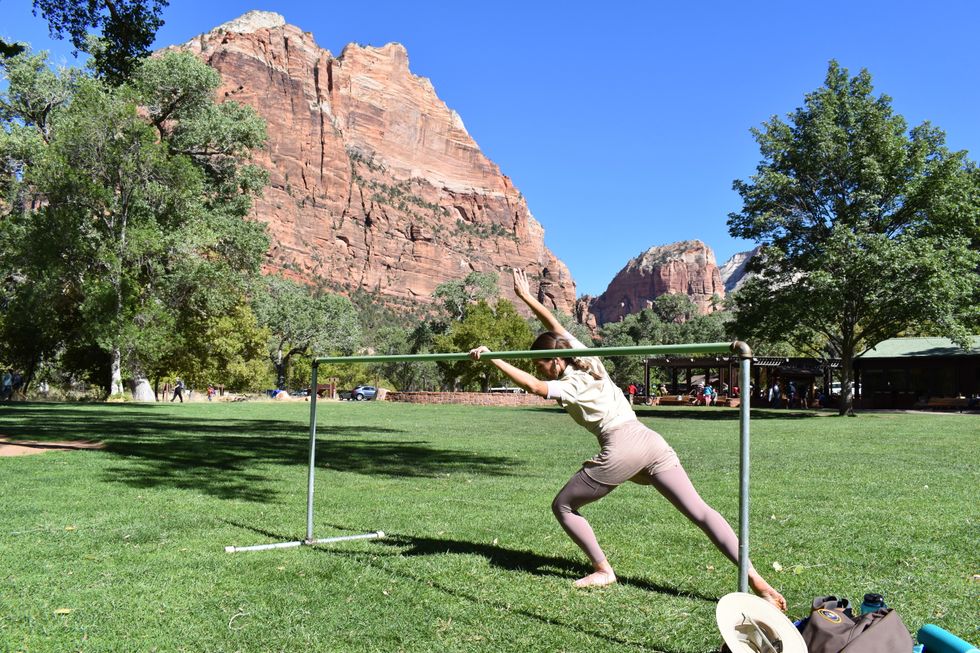
Courtesy Longoria
The director of the Salt Lake City–based Municipal Ballet Co., Longoria heard about Zion’s residency program several years before she decided to apply. She was originally unsure if they’d be open to hosting a dancer, but she was a lover of the Utah desert and several works she’d choreographed for her company had been inspired by nature—including Wilder, which featured performances in the mountains and near a river.
Longoria was one of 104 artists from various disciplines to apply for a 2019 residency. Only four were chosen.
As an artist in residence, she lived alone at a cabin that dates back to 1925. “Since I’m a mom and a wife, I’m not alone very often,” says Longoria. At first, she was homesick, but “eventually I got to like having this alone time. In the morning, I would grind the beans, make my coffee. Do it all nice and slow and open the windows, taking my time because I only had myself to get ready.” After donning her volunteer uniform of khaki shorts and a button-up shirt, she’d head to the nearby Zion National Park Lodge.
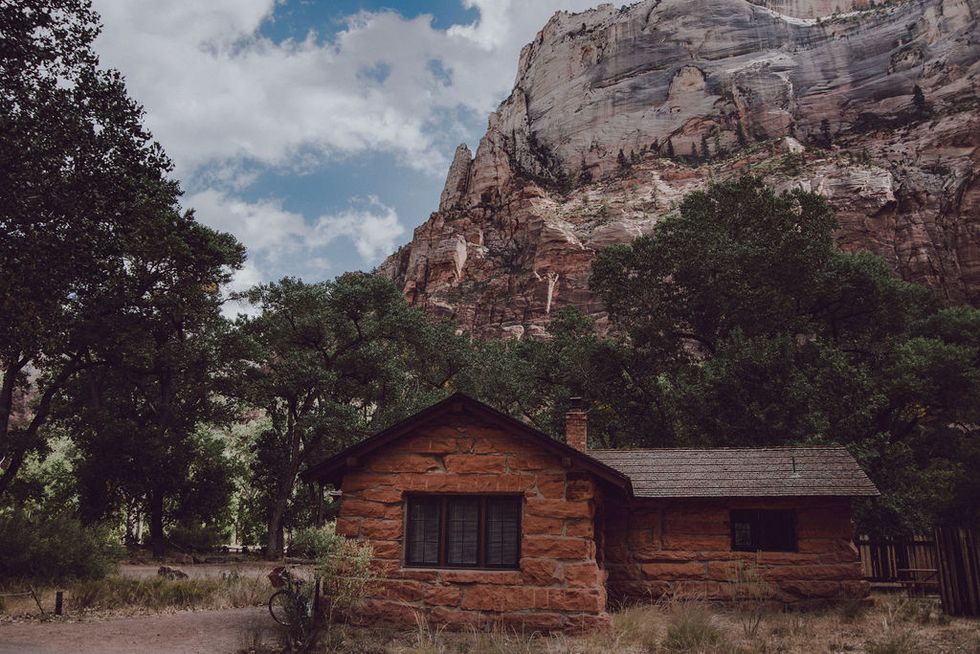
Jenna Pullen/Flint and Feather Photography, Courtesy Longoria
Longoria was free to explore her art however she wished, but she had to spend 20 hours a week interacting with the public. Whereas visual artists could easily host an open studio, allowing visitors to browse their paintings, Longoria chose to create her own open studio of sorts: Each day, she retrieved her portable barre from the lodge, set it up near a cottonwood tree on the expansive front lawn and gave herself class outdoors.
“A lot of people would stop and talk to me or ask what I was doing,” she says. Some asked, “Are you doing yoga?” Others told her about their grandchildren who dance, or reminisced about taking ballet themselves when they were younger.
Despite the varied reactions, it was an opportunity to dialogue about the arts. “I tried to not worry about getting through class at a certain pace,” says Longoria. One element was particularly illuminating: Longoria found herself explaining what a ballet barre was and how it was used for daily exercises. “I didn’t think a ton about that before: Most people don’t see ballet class, actually.” Whereas they might see a ballet performance, she explain, class might be totally foreign.
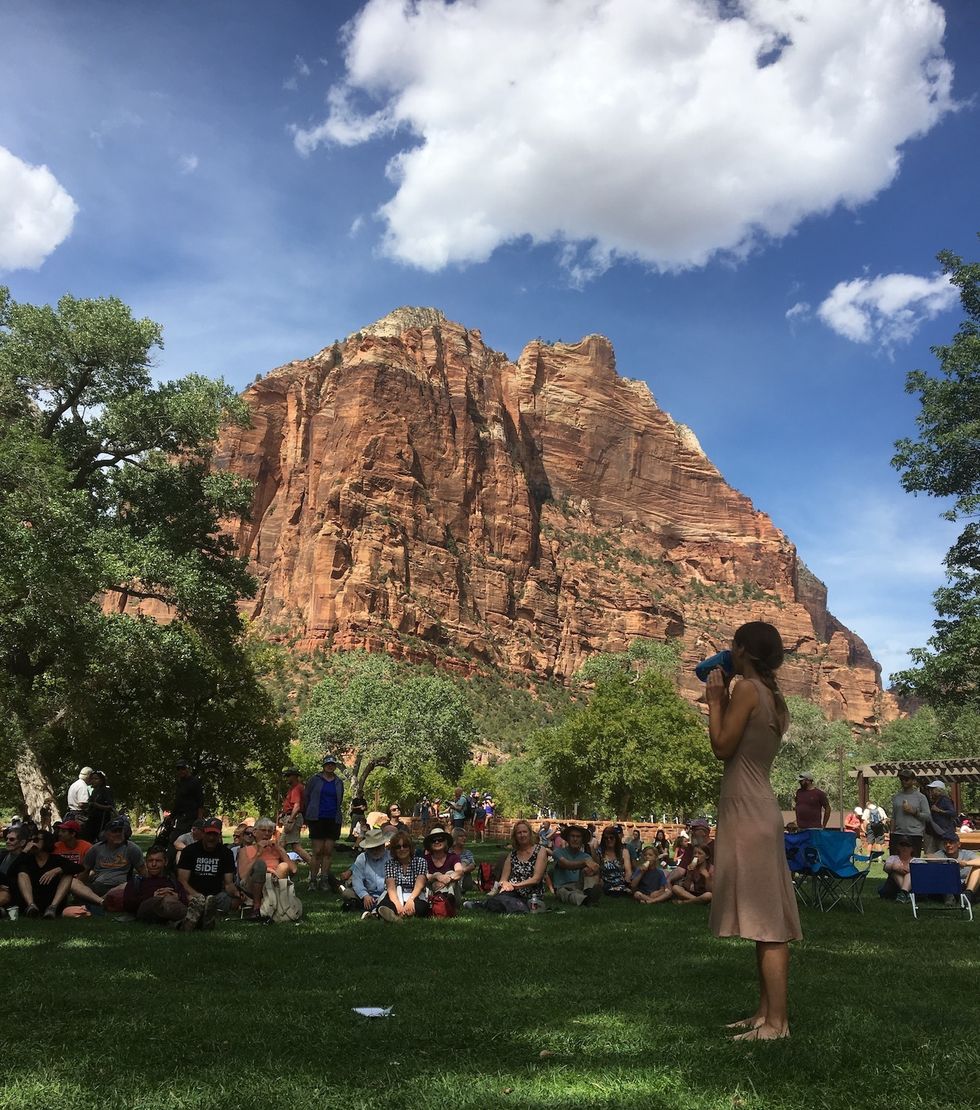
Courtesy Longoria
Longoria admits that, at first, taking barre in such an open environment was a bit uncomfortable. “Class is where we’re working on ourselves, so I had to remind myself that I’m a work in progress always and that this is just me practicing my art, and it’s okay to do it in front of people.” Presenting dance outside of a theater in a different context yielded some unexpected feedback from visitors. “People told me that they felt like they could see the shapes of what I was doing in the landscape, which was cool, because I was just doing a normal barre.”
In the afternoons, Longoria would often hike the trails in uniform. “I got to learn a lot about Zion because people would ask me questions,” she says. Aside from typical chores like laundry and cooking, Longoria filled the rest of her time with letter writing (as a way to keep in touch with family and friends without cell service), journaling about the experience and sewing a prototype of a costume for an upcoming ballet.
In exchange for the residency, all artists have to donate a work of art to the park. Longoria chose to choreograph an evening-length ballet, set to premiere in 2020 both in Salt Lake City and in or near Zion National Park. She’s collaborating with four local music groups on the projects and says, “I probably will send them excerpts from my journals, so they can see what it was like for me there.”
While Longoria was lucky to spend a month at a national park, she believes that all dancers can benefit from time outside of the studio. “The connection with nature is really important for humans, in general. I think that in our day-to-day lives we are pretty disconnected from our land because we have a lot of comforts—we have houses with air conditioning and heating and we drive from place to place and we are looking at our screens a lot. I think it’s really important for us to remember that we, too, are also natural. We’re a part of this earth.”
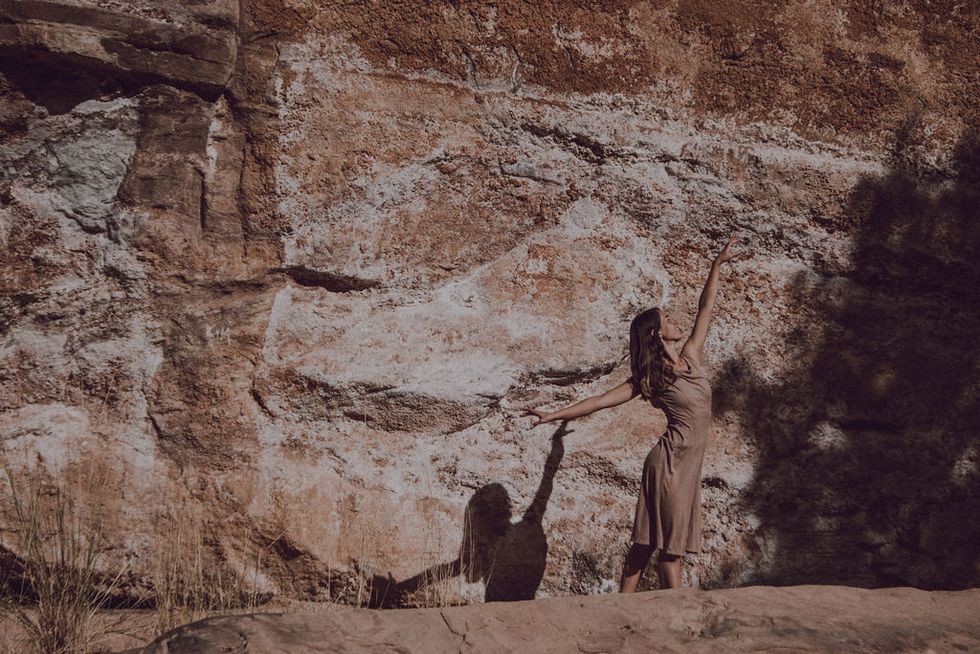
Jenna Pullen/Flint and Feather Photography, Courtesy Longoria
“I feel like during my formative years,” she says, “without realizing it, I was trying to be some other dancer or the picture of a dancer or thinking I needed to be a certain way. But I think that the art, and maybe also the technique, loses something when the artist isn’t fully himself or herself. Being in nature, you realize that you are part of nature. Nature, it’s not trying to be anything else. Realizing that can really help a dancer understand that being themself is the truest they can be.”
Longoria believes that authenticity translates to audiences, too. “I think audiences can be impressed with feats of technique and precision, but it isn’t going to bring meaning to their lives unless there’s humanity and generosity behind it. Nature doesn’t care what people think about it—it just is, and it’s beautiful. That’s what we human dancers can learn from it.”
The post This Dancer Spent a Month in Zion National Park as an Artist in Residence appeared first on Dance Magazine.
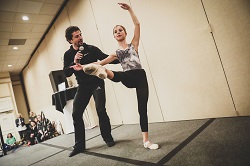
by Admin
What should students choose? College, concert or commercial dance?
As dancers chassé toward their senior year of school, they begin to decide where dance will take them. Where will they take that next step, or leap, to make their dance dreams a reality? There are so many options across college dance, the commercial scene […]
ran-&-raveAs dancers chassé toward their senior year of school, they begin to decide where dance will take them. Where will they take that next step, or leap, to make their dance dreams a reality? There are so many options across college dance, the commercial scene and company work. Will they audition for a feeder school in hopes to join a concert dance company, will they get an agent and seek commercial work, or will they dive headfirst into academic study at a leading college?
Traditionally, there has been a disparity between concert, commercial and collegiate dance careers, and young students can feel that their choice now may limit their career choices in the future or box them in. But is this changing? And how can you help your students to navigate the gap between these three very distinct dance worlds?

Martin Harvey at Dance Teacher Summit
Martin Harvey, former principal with The Royal Ballet, who is also an actor and Broadway performer, says, “On the surface, there is definitely a gap. However, underneath, we’re all going for the same thing.”
Commercial dancer Teddy Forance, who hails from a competition dance background, shares the same sentiment, saying, “I think there is still a gap, but it’s definitely closing more and more. I think University of Southern California was massive for the dance world to see. This college is built upon showing different ideas and concepts. You’ve got Forsythe, but then you also have commercial people coming in and teaching.”
Emmy-nominated choreographer Al Blackstone also feels like the gap is “absolutely closing”, adding, “I feel like I thrive in that gap! I enjoy adapting to the kind of audience that my work will have and figuring out how to connect with them most effectively. I try not to worry about which areas of the industry I fit into because ultimately, it’s all dancing, and that is the language that I feel most comfortable speaking.”
Harvey, Blackstone and Forance have all very successfully navigated that gap, enjoying exciting, varied and ever-evolving careers in many areas of the dance industry.
Forance speaks fondly of his recent work in the concert dance sphere with Hubbard Street Dance in Chicago. “It was really cool that they opened up the doors, were so generous and so kind, and really enjoyed my work. It was a really interesting collaboration.”
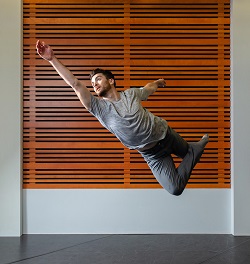
Teddy Forance. Photo by Katie Goughan.
Blackstone, who seems to jeté effortlessly across many spectrums of dance, is excited about the merging of different dance worlds, sharing that “dancers now have more access to information and training than ever before, and it means that dancers are able to be more versatile than ever. In New York, there are company dancers dancing on Broadway and ballet dancers doing music videos! Different communities are feeding off one another in order to evolve, and it means that the lines are increasingly being blurred.”
With these lines blurred, how can dance educators equip their students to bridge the gap so they, too, can achieve successful and fulfilling careers in any area, or multiple areas, of the industry?
Harvey tells educators to “encourage open-mindedness and provide/lobby for diverse and balanced training at their studios.”
Forance shares practical advice saying, “I think it’s about being informed. Map out on paper all the different options for colleges and the choices you can make. There are so many different things to research out there — for example, Arts Umbrella in Canada, has a way to do a year training program without an academic program.”
He adds, “Give them all the tools you can, and really be knowledgeable yourself across not only the competition convention scene but also the collegiate level, companies, what’s happening in LA. Talk about getting an agent and the process for that. I think there are so many things that go in to preparing someone to be a professional dancer, more than just how to move!”
Blackstone adds an emphasis on broad training. “I think that solid training and encouraging our students to have an open mind will always be the key to versatility. If we can encourage our dancers to be curious and try new things, then they will have a better chance of branching out in to different areas of the industry.”
Forance agrees. “It’s about being someone in the room who is just agile with anything that comes at them — words, or movement or energy,” he says.
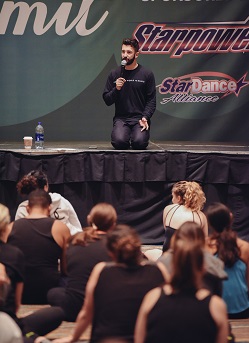
Al Blackstone at Dance Teacher Summit
“Hold your students accountable,” stresses Blackstone. “As a convention teacher, I see kids skipping classes all the time because they ‘don’t like’ or ‘don’t do’ that style. It breaks my heart because they are so young and already boxing themselves in and setting limits on what they think they are capable of!”
In addition, “Ask the students to invest in finding out who they really are,” digs Harvey. “Spend a little less time on ‘what’ is happening and more on ‘why’ and ‘how’ it’s happening. Suggest that the students might start thinking as if they were a director or a choreographer.”
Blackstone, who will be teaching at this summer’s Dance Teacher Summit (DTS) aims to help educators have these discussions so they can assist students to best navigate the industry. “Dance Teacher Summit connects the people who are responsible for fostering the next generation of dancers in this country. We come together to share ideas, try new things, have conversations and dance together. Regardless of what part of the industry we inhabit, it is the kind of place where you immediately realize how connected we really are.”
With leading educators and professional dancers and choreographers from across the commercial, concert and collage scenes speaking and instructing, DTS brings these worlds together in one place.
Harvey says, “I think DTS does a marvelous job of making an energetic fact into a tangible reality. We are all connected, and we do all care, so bringing us together to help further sculpt ourselves can only be good news for the future.”
And as Forance stresses, it’s all about being “informed”. We can’t all know everything happening in the industry, but when we come together, we can learn, grow and, very importantly, be re-inspired for the new teaching year.
“You’ve got to fill your cup back up before you let people drink from your inspiration,” says Forance.
Join Harvey, Forance and Blackstone at Dance Teacher Summit this July and August. For more information, visit www.danceteachersummit.com.
By Deborah Searle of Dance Informa.
The post What should students choose? College, concert or commercial dance? appeared first on Dance Informa Magazine.

by Admin
Costume Inspiration: Dance Costume Guide Out Now
It’s time to get inspired and excited for your next recital, so start looking at costume choices! This season there are so many gorgeous styles and looks to choose from, with hundreds of elegant, fun, cute, colorful and character designs. Dance Informa’s popular Dance Costume […]
ran-&-raveIt’s time to get inspired and excited for your next recital, so start looking at costume choices! This season there are so many gorgeous styles and looks to choose from, with hundreds of elegant, fun, cute, colorful and character designs.
Dance Informa’s popular Dance Costume Guide is out now, featuring the industry’s top dance costume designers and stockists.
Check out the 2016-17 Guide now and get swept away in glitz and glamour as you choose the looks for your next show or competition.
Danceinforma.us/recital-costume-guide
The post Costume Inspiration: Dance Costume Guide Out Now appeared first on Dance Informa Magazine.

by Admin
CLI Studios: Inspiration, Collaboration and Education
Note: CLI Studios has recently revised its products and services to provide them all through its Studio Partnership Program, where CLI works directly with dance studios. Stay tuned for a new article on CLI’s programs in 2018! It is rare to find a dance company so willing to […]
ran-&-raveNote: CLI Studios has recently revised its products and services to provide them all through its Studio Partnership Program, where CLI works directly with dance studios. Stay tuned for a new article on CLI’s programs in 2018!
It is rare to find a dance company so willing to be about the artist, and not ulterior motives. CLI Studios is about the artist. They’re more about the dancer and teacher learning and continuing to stay inspired, and less about how much money they make at the end of a fiscal year. CLI Studios is about the choreographer, the dancer, the teacher, and the studio owner growing and collaborating to fuel the world of dance through online sharing. This is a business model I can get behind.

Co-founders Jon Arpino and Teddy Forance. Photo by Rob Daly and Quinn Wharton.
About two years ago, CLI Studios Co-Founders Jon Arpino and Teddy Forance were talking about how Forance and a few other notable choreographer friends receive requests from studios all around the country and world to teach master classes. Time for these renowned choreographers, however, is precious and rare. Also, unless you live in New York or Los Angeles, it is unlikely you have the opportunity to take class from Allison Holker, tWitch, or Caitlin Kinney on a weekly basis.
Enter CLI Studios – an online dance class sharing platform that allows members the opportunity to learn from 40 different choreographers at any given time for a low price.
As stated on its website, “Every week, CLI Studios uploads instructional videos of our choreographers to the members-only section of this site. The videos include full combinations, warm-ups, across the floor combinations, and strength and conditioning exercises from some of NYC and LA’s top choreographers. These videos allow dancers and teachers around the world to take classes on their own time and schedule, for an incredibly affordable price. CLI Studios is a great supplement to a dance studio education, and a great way to continue your education after life at a dance studio.”
Arpino says there are three different programs from which to choose.
 “The first studio package is for $100 per month,” he says. “Some studios have 20 teachers, and we offer access for the entire faculty for a flat fee. The more teachers you have, the more cost effective it becomes. Then we have a program for teachers for $40 per month. That’s super popular. Right now, we offer two classes per week for teachers, so that’s about $5 a class. And then we offer a program for dancers that’s $20 per month. They get fewer classes than the studio program, so it’s not like a library of classes like the teacher and studio program, but it’s still less than $5 a class.”
“The first studio package is for $100 per month,” he says. “Some studios have 20 teachers, and we offer access for the entire faculty for a flat fee. The more teachers you have, the more cost effective it becomes. Then we have a program for teachers for $40 per month. That’s super popular. Right now, we offer two classes per week for teachers, so that’s about $5 a class. And then we offer a program for dancers that’s $20 per month. They get fewer classes than the studio program, so it’s not like a library of classes like the teacher and studio program, but it’s still less than $5 a class.”
Some of the choreographers represented at CLI Studios include the aforementioned Teddy Forance, Allison Holker, tWitch, Caitlin Kinney, as well as Kathryn McCormick, Nick Lazzarini, Kenny Wormald, Kyle Robinson and many more. Most of these choreographers travel with conventions, tour as back-up dancers, or perform on shows like So You Think You Can Dance and Dancing with the Stars, staying constantly busy.
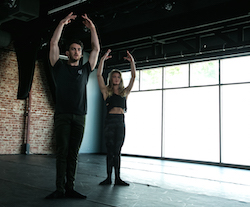
Teddy Forance and Caitlin Kinney, choreographers for CLI Studios. Photo by Rob Daly and Quinn Wharton.
“We filmed with over 40 different choreographers within the last year,” Arpino states. “It is the first time I know of where you are able to take a class from all of these renowned choreographers at your own time, in your own space, from anywhere in the world. It gives people a great opportunity to learn from some of the top choreographers in the country. We’re always looking for more ways to educate and inspire people, and get dance videos online.”
CLI Studios offers multiple styles of dance, including jazz, contemporary, ballet, basic technique, hip hop, salsa and more. “We like to keep it diverse in terms of styles,” Arpino says. One benefit of CLI Studios for teachers is learning a multitude of dance styles that you may not be as comfortable with, and keeping up with ever-evolving dance trends.
“If you’re teaching at a studio but you’re not a hip hop teacher, you could watch one of these videos, learn four to six counts of eight of the Intermediate Hip Hop class and teach that,” Arpino explains. “Even though a certain style might not be your go-to style as a teacher, someone like Kenny gives you choreography that you can effectively and efficiently teach to younger students. That’s the benefit of doing it online – you can experiment with different styles and not jump into a class when you might be in over your head as a dancer or teacher.”
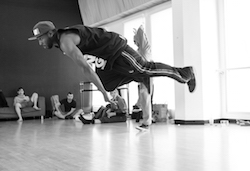
Twitch instructing a class for CLI Studios. Photo by Rob Daly and Quinn Wharton.
To those who would question the idea of dancing at home, and the safety concerns involved with that, Arpino says he is not worried as of now. He says, “Right now, we offer intermediate and advanced classes that are really geared toward dancers who are training at studios pretty frequently. On a technical level, it’s really up to you to know what you can and can’t do. No one in the video is telling you to do an ariel for the first time.”
He continues, “As we branch out in to more intermediate styles, I think [safety] is definitely something we’ll have to be very conscience of. We’re teaching people how to move who might not have the experience or the flexibility. Our choreographers are really good at teaching different moves that are challenging or something that might be pushing you, but they’re good at breaking it down and not pushing someone too far.”
CLI Studios wants to challenge, inspire and continue collaborating with many different artists and choreographers. One of those artistic humans is Wade Robson. CLI and Robson recently worked together to create a short dance film entitled FLIGHT.
About Robson, friend and collaborator Teddy Forance says, “Wade and I have wanted to work together for a long time. CLI is definitely in the instructional video space. We’re not really a dance film company, but any time you have any opportunity to work with a great choreographer or great director, I think that’s what we want to do…to offer not only education, but inspiration for our teachers, students and fans.”
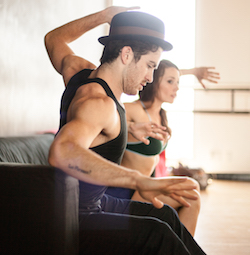
Teddy Forance and Jaimie Goodwin. Photo by Rob Daly and Quinn Wharton.
FLIGHT, the multitude of choreographers, the low cost and the quality of classes available…all of these aspects of CLI Studios are solid reasons for becoming a member of the online dance studio platform.
Co-Founder Forance says it best. “We’re not about replacing your dance studio, or telling you not to go to conventions,” he concludes. “It’s an awesome supplement for a really low price to just stay inspired. For people who want to keep learning and improving, this is a great tool for those goals. Whether you’re a studio, teacher or a dancer, we have a program that we’ve customized for you based around your core values of inspiration, collaboration and education.”
To become a member of CLI Studios, or to learn more, visit www.clistudios.com.
To watch FLIGHT directed by Wade Robson, visit www.clistudios.com/flight.
By Allison Gupton of Dance Informa.
Photo (top): Caitlin Kinney, co-creator and choreographer for CLI Studios. Photo by Rob Daly.
The post CLI Studios: Inspiration, Collaboration and Education appeared first on Dance Informa Magazine.

by Admin
This new year, take ‘I’m too busy’ out of your vocabulary
This new year, take “I’m too busy” out of your vocabulary for healthier body and mind, and dive with your whole self into a richer life. “Oh my goodness, how are you?” an old friend squeals when I see her at the store recently. “Busy,” […]
ran-&-raveThis new year, take “I’m too busy” out of your vocabulary for healthier body and mind, and dive with your whole self into a richer life.
“Oh my goodness, how are you?” an old friend squeals when I see her at the store recently. “Busy,” I reply with my default answer. “Oh I knoooowww, we’re so busy, too,” she says, rolling her eyes; both of us using the word “busy” like we won some kind of prize for how great our lives are. My newsfeeds declare: “Busy is the new normal”, “Busy is the new happy”. Studies show that stress plays a role in so many real health consequences: anxiety, insomnia, stomach pain and weight gain just to name a few.
This new year, join me in resolving to take back our health by not letting “busy” justify nourishing our bodies with artery-clogging, high calorie, low nutrient, dense food. We have the power to choose how we fill our time and what we fill our bellies with. The food you eat is broken down into building blocks for new cells, for the production of new muscle tissue, for recovery, and for every biological process that makes us work and affects our aging. Let’s choose those building blocks with intention.
Join me this year in taking back what we fuel our bodies with because we quite literally are what we eat. Here’s how we are going to do it:
Planning! Have good stuff on hand. Meal and snack planning is worth your time, and if you want to be healthier in 2016, it is not optional.
- Make sure you always have healthy snacks on hand at home. Always have a fruit basket, nuts, hummus, yogurts, cup of soups and pre-made bars, so when you get hungry and you need something to grab it’s already there.
- Have pre-washed greens in your fridge at all times. They can be thrown in salads, in soups, or paired with a frozen veggie burger.
- Quickly sketch out an outline for your most challenging meal. Make a list of the key components. It can be on the back of an envelope or on your phone. Just enough information to make sure you have a few key ingredients on hand at home. For example:

Now, at the store you know you need at least veggies, greens, lentils, beans, bread and pasta.
Technology can be awesome; let’s use it! There are lots of websites that will meal plan for you and even deliver pre-made meals right to your door. On your busiest day, have Thrive Foods Direct send your meal right to you. Here are my favorites:
A slow cooker/crock pot will save your life.
Every one of the meals listed in the chart above can be made in a slow cooker (some recipes are on my website). Beans, lentils and peas are longevity foods, according to the Blue Zones Project; plus, they have protein, iron and fiber. They can be thrown in the slow cooker in the morning, and by evening you have dinner ready for you. They are an inexpensive and health-promoting source of protein and go in many different dishes from Tex-Mex to Mediterranean to Indian.
Let your freezer make your life easier.
Make large batches of beans, peas and soups, and then freeze in small glass containers like Pyrex or even mason jars. Stock up on frozen veggie burgers, edamame, peas, corn and whole grain breads like Udi’s Millet Chia bread.
Invest in a good blender.
Get in the habit of making smoothies at least two times per week. Use almond milk (a good source of calcium and vitamin D), Swiss chard leaves, frozen berries and chia seeds for a calcium rich but plant-based snack. I throw nuts and seeds in the blender to thicken it up and to provide protein and healthy fats.
Have premade snacks ready to go.
Try the Dr. McDougall’s Right Foods brand. They are meals in a cup that can be heated in one minute, cost less than $2/serving and are delicious and healthy.
Buy or make hummus and use it as a dip for veggies every day. Use it as a quick dressing for kale salad by massaging hummus and lemon juice into the kale, and done! Have storebought or homemade bars with you every day. I like the Kind bars, Bobo’s Oat bars, Lara bars and Barre bars. I also have recipes for no-bake almond oat bites on my web site, www.dancernutrition.com.
I’m done with the glorification of busy in place of a healthy lifestyle. Let’s make healthy eating a priority this year!
By Emily C. Harrison MS, RD, LD of Nutrition for Great Performances.
Emily Harrison

Emily Cook Harrison MS, RD, LD
Emily is a registered dietitian and holds both a bachelor’s and master’s degree in nutrition from Georgia State University. Her master’s thesis research was on elite level ballet dancers and nutrition and she has experience providing nutrition services for weight management, sports nutrition, disordered eating, disease prevention, and food allergies. Emily was a professional dancer for eleven years with the Atlanta Ballet and several other companies. She is a dance educator and the mother of two young children. She now runs the Centre for Dance Nutrition and Healthy Lifestyles. She can be reached at emily@dancernutrition.com
www.dancernutrition.com
The post This new year, take ‘I’m too busy’ out of your vocabulary appeared first on Dance Informa Magazine.

by Admin
Dance Studio Owners: Are you making this mistake?
The BIGGEST mistake Dance Studios are making in their marketing right now… Here’s a BIG question for you this week, lovely Dance Informa readers! When it comes to your studio, are you marketing what you DO or are you marketing what you GIVE? You see, […]
ran-&-raveThe BIGGEST mistake Dance Studios are making in their marketing right now…
Here’s a BIG question for you this week, lovely Dance Informa readers!
When it comes to your studio, are you marketing what you DO or are you marketing what you GIVE? You see, one of the biggest challenges is how to promote your studio in a highly saturated, competitive market when EVERYONE is trying to promote the same thing!
Every studio offers ballet, jazz, tap, hip hop etc. We need to discover your unique positioning and differentiation in the market.
The wonderful thing is that every studio is different. Some studios are more technique focused. Others give amazing performance opportunities. Whilst some studios pride themselves on individual nurturing and personalized attention.
Really step into the hearts and mind of that parent who is choosing a studio for their child. What are they looking for? What is important to them? How do they want their child to feel? What would turn them off choosing your studio? The more we can understand what your dream student is seeking in a studio, the more we can tailor your marketing message to speak directly to their hearts.
In a nutshell, shifting your marketing message to share what the students will EXPERIENCE at your studio as opposed to what you do in your studio is a wonderful way to connect more with your marketing and start attracting more students.
It’s not about the class itself, it’s about painting a beautifully vibrant picture of how they’re going to feel when they’re in the class.
The studio with the most connection in their marketing will win – and the best thing is that all it takes is a few little tweaks.
In the comments below, share how you describe the experience at your studio…
And, if you’re looking for more guidance on how to craft your studio’s marketing message, the best place to start is in the Free “30 Enrollments in 30 Days” mini course. This course has been designed for studio owners and will walk you through how to rapidly ramp up your registrations. Click here and watch the first video now.
Here’s to more passion, more profits and more purpose in your studio!
All my best,
Chantelle
By Chantelle Bruinsma Duffield of studioexpansion.com
The post Dance Studio Owners: Are you making this mistake? appeared first on Dance Informa Magazine.

by Admin
A letter to my students: Create Stories that Matter
Vincas Greene was Chair of the Department of Dance at Brenau University in Gainesville, Georgia, and worked there for 21 years. Students adored him and affectionately referred to him as “Master Greene”. Upon leaving Brenau and moving to Spokane, Washington, to continue to develop his […]
ran-&-raveVincas Greene was Chair of the Department of Dance at Brenau University in Gainesville, Georgia, and worked there for 21 years. Students adored him and affectionately referred to him as “Master Greene”. Upon leaving Brenau and moving to Spokane, Washington, to continue to develop his art form, Greene communicated to his students via a heartfelt letter. That letter, his “last message”, was so inspiring that we wanted to share it with our readers. Maybe you could empower your dance students with a similar message?
My dear dancers,
I would like to preface this with the note that I love you. You all know Terpsichore is a hard mistress, and we empower her to keep her eagle eyes upon us so that we may constantly be prepared as her emissaries or, as Martha Graham calls us, “Athletes of God”. To this end, I must challenge you to accept these words from a teacher/friend/elder/lover who wants each of you to be the best artist, dancer and person you can possibly achieve.
The Scottish psychologist R.D. Laing wrote, “Life is a sexually transmitted disease, and the mortality rate is 100 percent.”
This entwines with our lives as dancers so well – Dance is passed from one person to another in a centuries’ old chain we can gaze back upon seeing our ancestors as they struggled, loved and taught each other, transmitting their knowledge, discoveries and passions over the years to our most recent teachers, to each of us and then on to our students and, in my case, to my grandchildren of dance. Dance is the physical manifestation of passion, and dancers are the vessels. We become so full of passion it leaps out as dance, love and art. No wonder the world sees us as sensual because our life is communication made physical. Even as our bodies begin to slow, our minds still rage with the exuberance of youth as we picture new dances forming and how our dream-perfect bodies would experience each movement. You can see it in the eyes of our elders as they describe to us past performances and new ideas – and we can also see it as their bodies still enact, as best they can, each nuance that is being described. But we know that for each of us, eventually, the body and the mind come to perfect stillness and the end of the dance, when the performer leaves the stage.

Vincas Greene teaching Brenau University dance students. Photo courtesy of Greene
The time between discovering our passion for dance and the stillness should be full of stories. A story to be spoken or danced is what we have to offer – to contribute to those with us now and those who will hear of us later. Remember, dance is the most ephemeral of the arts, so it is our stories that we leave behind when we leave the stage. I am challenging each of you to create stories that matter. Have experiences that will help you to live stories of excitement, challenge, trepidation, pain, redemption, love…stories that are powerful!
I remember talking to a highly accomplished dancer and having her explain some of her experiences with touring, choreographers and other dancers. She just considered them her own experiences. When I told her that she should tell those experiences to her students as stories, she looked at me with confusion. She didn’t consider her life as a story but just as a personal event. The idea that her life could be shared to teach, motivate, warn and even entertain came as a shock to her. Her life is truly amazing, and she has started to share it as stories for her students, and the stories will be passed on now to illustrate that dance matters. The idea that my life and your life stories are to be created has me stirred up.
This idea has me contemplating fear, regret and risk. Mark Twain said, “Twenty years from now, you will be more disappointed by the things you didn’t do than by the ones you did. So throw off the bowlines, sail away from the safe harbor, catch the trade winds in your sails. Explore. Dream. Discover.”
As you sit here listening to me, check in with yourself. Notice what thoughts are being stirred up. Notice what you think you ought to be doing or pursuing. Notice what you think would be best for yourself as opposed to what others think would be best for you. Notice now the thought at the edge of your mind that is terrifying. The “if only” or “what if” thought that you immediately reason away – it’s not practical, that’s not possible, everyone would think I’m crazy, my parents/friend/lover would be so mad at me, that’s only for special people – whatever your excuse to cancel that thought out. That is the thought that stories are made of! Embrace that thought, challenge yourself to that thought, wrestle with that thought (like Jacob with God for his blessing), and find your path to your story.
This will also take work and sacrifice. I am not saying drop everything and go a new way. You must discover, invent and plan your way. Being here is a wonderful way to follow this path. But while you are here and wherever you discover yourself in your story, you must embrace it fully. Don’t let yourself be set on cruise control, don’t take the easy way, don’t skip the steps that will make you learn and grow – these all lead to a boring story that you won’t even interest yourself in telling. As a dancer, this means learn your craft and craft your vessel. A flaccid leg is a smudge, not a line. It takes muscles to move your body, understanding to know what you want to achieve, desire to push yourself to excellence – dance must matter to you, matter to the very core of your soul! The first plié in class must matter to you. If it doesn’t, it is just wasted time, energy…wasted life. The dancer cares for each movement, as the poet places each word thoughtfully and carefully in the verse. Place your dancing in the middle of your love. Care for your dancing, learn your dancing, learn about your dancing, tell others the small stories you are creating about your dancing, carry your dancing with you; don’t leave it to be picked up in the corner of the studio whenever you happen to be there.

Vincas Greene with Brenau University dance students. Photo courtesy of Greene.
I believe dance as life is terrifying. To approach each day as the day to improve your craft, make yourself stronger, give yourself more knowledge, and challenge yourself to be greater than the day before is ultimately a scary life. There is nothing easy about choosing to dance – you must constantly defend your choice, challenge yourself physically and mentally, listen to constant critique, and believe that what you are doing matters – matters to yourself, matters to art, matters to our world.
Be courageous in your belief that your life story matters. It is truly a risk to embrace the arts as life, and choosing dance among the arts is probably the riskiest. Following a path of passionate dance is not easily understood by our society. But our society also loves the underdog who takes a risk to pursue the elusive dream. Telling that story, your story, of how you are on the path is the story that draws people in to you. They are illuminated by the fire of your passion and excited by the depth of your dedication.
The world is littered with people who didn’t risk themselves. Their stories are boring, uninspiring and predictable. I remember the absolute fear of starting my life story in dance. I remember the fear of starting new chapters in this story – when I was moving to New York and really just wanted to stay home. The transition of sitting on the jet, mortified at what I was doing, and then relaxing into the adventure when the wheels left the ground and there was no turning back. As you know, I am starting a new chapter in my life story. My stories are getting a little worn, this chapter needs to end, I am terrified of what lies before me and just want to rush back into the comfort of being your “Master Greene”, but another chapter of new stories with adventure, creation, challenges, failures and accomplishments is tantalizing…also, how can I lead if not by example? I can’t have you lose faith in me. So, my parting advice to each person here today: “Take the path that is the scariest to you. Only by risking will you overcome your fears and learn something new. Don’t regret that you didn’t take the chance. Work like it matters and don’t accept less from yourself. Make your story an exciting one.”
With love,
Master Greene
Photo (top): Vincas Greene with Brenau University dance students. Photo courtesy of Greene.
The post A letter to my students: Create Stories that Matter appeared first on Dance Informa Magazine.
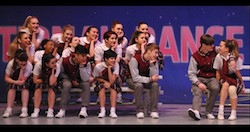
by Admin
Allegro Performing Arts Academy: Secrets to Success
Several elite protégés at PULSE dance convention, numerous awards, and a win for Best Musical Theatre number at this past August’s Industry Dance Awards (for the third year in a row). That smells like success. So how does one studio do it? Allegro Performing Arts […]
ran-&-raveSeveral elite protégés at PULSE dance convention, numerous awards, and a win for Best Musical Theatre number at this past August’s Industry Dance Awards (for the third year in a row). That smells like success. So how does one studio do it?
Allegro Performing Arts Academy, located in Kent, Washington, sure knows how. The Industry Dance Awards go to the best competition dance pieces from studios all over the United States, and Allegro Performing Arts Academy, a winner year after year, has been reaping in success.

Allegro Performing Arts students performing ‘Can’t take my eyes’. Photo courtesy of Allegro.
Tonya Goodwillie, owner and artistic director of Allegro, notes that the studio’s accomplishments are due to “perseverance” and “versatility”. Tiffany Miles-Brooks, co-director of Allegro Precision Dance Company, along with Goodwillie, adds that it’s all about “staying updated”.
“From the beginning, it was really important to us that we train equally in all styles,” Goodwillie remarks. “And as much as people fought us on that, it’s really proven to be a great part of our dancers’ training that are doing so well now. They’re not only tapping and doing great as tap dancers but also hip hop and musical theatre. So the versatility has been a really big part of our success over the past 10 years.”
“And then also just bringing in choreographers from the industry and always staying new,” adds Miles-Brooks.
Some of Allegro’s guest choreographers have included Emmy-winning Tessandra Chavez, top performer Gina Starbuck, So You Think You Can Dance’s Abe Obayomi, commercial dancer and choreographer Seth Zibalese and more.
As leaders, Goodwillie and Miles-Brooks encourage their studio’s staff to continue to learn and attend teacher workshops, in an effort to stay on top of the industry and to impart the best knowledge to their students.
“I think, as teachers, we feel pressure because we have such great dancers, and we have such great kids who are coming up, young dancers who are coming up, too, that we want to keep doing the best for them, and continue to provide them with everything that we possibly can,” Goodwillie explains. “And dance is an art form. It is constantly changing, so we can’t be stagnant. We have to constantly thrive to be better ourselves. So whatever we can do to better ourselves as teachers is going to better our students in the long run. So, it’s really important.”

Tonya Goodwillie and Tiffany Miles-Brooks with Rita Moreno at the 2015 Industry Dance Awards. Photo courtesy of Goodwillie.
At Allegro, Goodwillie has also assigned different chairs to each of discipline’s departments. Miles-Brooks, for instance, is the chair of the Jazz Department; faculty member Sara Palmer is the chair of the Hip Hop Department. Each week, the department chairs connect, communicate about their students and brainstorm what they can work on, as a collective studio.
“I think it’s all about communication,” Miles-Brooks adds. “A lot of studios, they bring people in, they kind of do their job, and they leave. I feel like we have this system, and we’re constantly together, constantly brainstorming, constantly thinking of what we can do collaboratively.”
Allegro’s group of teachers are equally invested in their students and even offer as mentors. Perhaps it is this sense of “team” that has also trickled down to the student’s own desire to progress.
“We have a mentorship program for our kids, and so we get really in tune with what they want to do with their career, and we help them as best we can,” Miles-Brooks says. “Such as research colleges, research companies that they may try and get in to, getting in tune with what they want to do. So that really helps. A lot of them want to choreograph, so we give them opportunities to choreograph on dancers, and put on shows.”
“No one did that for me growing up,” Goodwillie adds. “I didn’t have that at all – the opportunity to explore what’s after high school. No one sat me down and talked about, ‘Well there’s this college, and you don’t have to go to college right away, there are all these other options.’ I didn’t know anything about the industry and agents. I had no idea. So it’s great for the kids to kind of get a feel of that. And then they can make a better, well-educated decision about what they want to do.”

Allegro Performing Arts Academy. Photo courtesy of Allegro.
Allegro’s most recent big win, the award for Best Musical Theatre number at August’s Industry Dance Awards, actually came as a pleasant surprise. The studio’s number was choreographed by Eddie Strachan for the third year in a row, and still Allegro proved to be on top.
“I actually came into this going, ‘There’s no way we’re going to get it a third year in a row,’” Goodwillie comments. “There were some really great other musical theatre pieces. Three other teachers came with us, and we’ve been having a really good time, and this is just a really cool event, so we’re just like, ‘Let’s celebrate and enjoy it. And whatever happens, happens.’ If you put the numbers together of how many competition pieces were nominated – there were eight categories, six to seven in each category, and those 50 numbers were chosen from thousands of group numbers. So just to be a nominee is really cool, too.”
And there, Goodwillie possibly suggests one more secret to Allegro’s success: a good, positive attitude and respect for others in the industry. Bravo, Allegro Performing Arts Academy.
By Laura Di Orio and Deborah Searle of Dance Informa.
Photo (top): A student at Allegro Performing Arts Academy. Photo by John Roque.
The post Allegro Performing Arts Academy: Secrets to Success appeared first on Dance Informa Magazine.
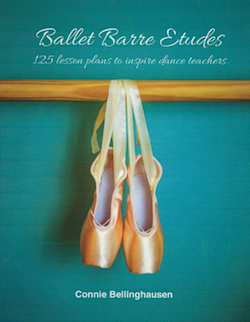
by Admin
Longtime Ballet Teacher Publishes Lesson Workbook
Connie Bellingshausen has taught dance since 1972, giving her over 40 years of experience in creating and executing lesson plans. While she has also taught jazz, tap and even period dancing (including Irish and Scottish dances), her main focus has been ballet. Now, much of […]
ran-&-raveConnie Bellingshausen has taught dance since 1972, giving her over 40 years of experience in creating and executing lesson plans. While she has also taught jazz, tap and even period dancing (including Irish and Scottish dances), her main focus has been ballet.
Now, much of her ballet expertise is available to the wider public, as she has published Ballet Barre Etudes: 125 Lesson Plans to Inspire Dance Teachers. For all those dance teachers in need of a go-to resource for those days they didn’t spend as much time preparing their warm-ups, these ballet barre lessons are good sources of inspiration in a moment’s hurry.
Dance Informa met Bellingshausen at a dance costume showcase event in September, where she shared information about her new ballet workbook. Here, we catch up with her again to hear a little bit more.
Connie, what is your teaching background?
“While living in Arkansas, I ran my own studio and taught dance for the University of Central Arkansas. There, I choreographed eight musicals for the theater department, including West Side Story, Pippin, Godspell and Guys and Dolls. While there, the university awarded me for my choreography of King Stag.
I’ve also studied and become certified in Scottish Country Dance, which I still teach now for the Highland Dancers of St. Louis. But for the most part, my focus has been on teaching ballet, tap and jazz.”

‘Ballet Barre Etudes: 125 Lesson Plans to Inspire Dance Teachers.’
What led you to publish Ballet Barre Etudes?
“After returning from vacation, I was cleaning out a file cabinet with a stack of spiral notebooks filled with lesson plans. Some were close to 35 years old. Many were written in pencil, and the writing was fading. I decided I would start putting them on the computer so I could refer to them when needed. I did this for several weeks and said to myself, ‘I’ve got a book here!’
I wish something like this had been available to me when I first started teaching. Life would have been so much easier. Teachers are so busy these days and my intentions for the book is to make their lives easier.”
Out of the 125 lesson plans included in the book, do you have any favorites?
“I don’t have a favorite lesson. When putting together a lesson plan, I often will consider what the students need at that time or incorporate part of the barre for a combination that I will later teach. Now that I have my book, I try to include one exercise from it that is unique. This makes class more interesting for my students and me. An example would be the pliés in lesson 142.”
You mention Gail Grant’s book, Technical Manual and Dictionary of Classical Ballet, in the introduction. What other dance resources do you recommend to teachers?
“I have quite a collection of dance books! When I first started teaching there were hardly any books available. In my collection I have a couple of out of print books. One is The Chalif Text Book of Dancing Book V. The pictures are great and include Harriet Hoctor, Grace Cody, Marley and Adeline Rotty.
Another book is A Manual of Classic Dancing by Sergei Marinoff. It is leather-bound, published in 1924 in Sunnyside Avenue, Chicago. It is a mail order dance class! He promises to send you a bar (his spelling), costume, slippers, photograph record with his voice over the music and exam questions that must be answered and sent in to him. There are photos of Ruth Page, Georgia Ingram, Eileen Weir and many others. I have tried to find out more about this teacher…
My favorite book for reference is The Classic Ballet, published by Alfred A. Knopf. The illustrations and descriptions are great.”
Lastly, what is your number one piece of advice to other dance teachers/studio owners?
“Never give up on a student. We are Americans not american’ts.”
To learn more about Ballet Barre Etudes, head to Amazon.
By Chelsea Thomas of Dance Informa.
The post Longtime Ballet Teacher Publishes Lesson Workbook appeared first on Dance Informa Magazine.
